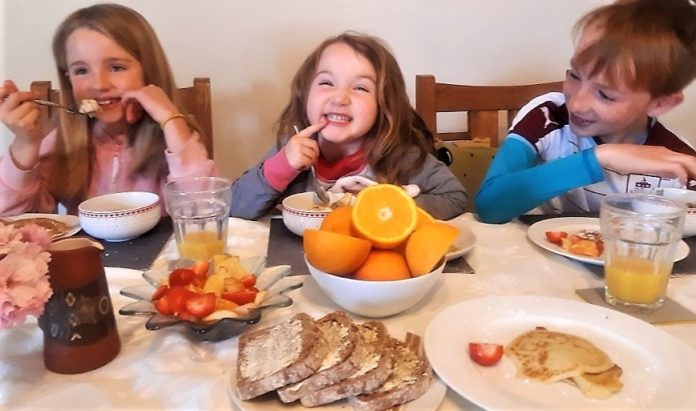
HSE Dietitian, Olivia Kelly Holton, says establishing a good breakfast routine won’t solve all our problems but starting the day on the right nutritional route can make the rest of the day a little easier during covid-19.
Lockdown Your Kids Breakfast
Living with lockdown brings huge challenges to parents, the realities of working from home, managing home schooling and trying to keep children active can leave us tearing our hair out.
While establishing a good breakfast routine won’t solve all our problems, starting the day with the right nutritional route can certainly make the rest of the day a little easier on our much loved little ones.
Spending time at home gives us an unique opportunity to instil good eating habits within the household and to be good role models for our children’s dietary choices. While we wont get it right all the time here are seven tips to help with our children’s breakfast
Eating a good breakfast in the morning helps young bodies break down glucose which is an important energy source.
Research has shown that eating fruit, grains and good quality protein within a couple of hours of waking up helps to avoid glucose fluctuations throughout the day.
Glucose fluctuations can cause mood swings, hyperactivity and poor concentration in our little darlings and stress in adults, a combination best avoided in lockdown.
A healthy breakfast also jump starts your metabolism; a good metabolism means kids burn calories well throughout the rest of the day.
Studies show that people who skip breakfast can have a sluggish metabolism causing them to gain extra weight leading to a viscous circle low activity, high cholesterol, high blood pressure and heart disease in later life.
So what constitutes a good breakfast?
No Mickey Mouse Cereals or Yogurts.
Breakfast cereals are an important part of Irish breakfasts and the milk helps contribute to the calcium & Vit D intake for growing children.
Our computer and TV screens are full of ads for breakfast cereals, fromage frais and yogurts marketed to children using attractive packaging and cartoon characters.
Most of these cereals are loaded with sugar and salt and as a rule of thumb we should avoid breakfast products with cartoon characters and described as chocolate, coco, frosted, honey or crunchy nut.
These sugar coated cereals contain 2-3 teaspoons of sugar per serving which is half a child’s sugar requirement for the whole day!
Aim for the Top 3.
The three healthiest cereals are porridge, wheat biscuits and shredded wheat because they are high in fibre and low in sugar and salt.
These cereals contain only 0.5 teaspoon of sugar per serving and provide a slow and steady release of energy throughout the morning thereby helping with concentration and homeschooling.
For the best results serve these cereals with low fat Vit D fortified milk and some chopped fruit. Low fat milk is suitable for all ages including children from the age of two years as it still provides the same calcium and protein found in full fat milk.
If you are finding it hard to switch your children to the healthier cereals at the start allow them to have their sugary cereals on weekends only and wean them off that way.
Younger children could put a homemade sticker or picture of their favourite character on the box to help ease the change.
Open A Juice Bar!
While this is probably not something that can be done everyday it can be a great time for the kids to set up their own breakfast juice bar.
Getting our children to help make freshly squeezed orange or grapefruit juice in the morning is a great way for them to learn all about the benefits of fruit and vitamin C.
Impress your children by telling them that one orange contains over two hundred disease fighting chemicals or antioxidants. By squeezing the juice of three medium oranges this produces approximately 150ml of juice.
This would be enough to do a taste test challenge with the family and compare how much better the homemade juice tastes against the shop bought juice which is made from concentrate and with added sugar.
Make Any Day Pancake Tuesday.
Eggs are also a very versatile nutritious food and are a great source of protein, iron, Vitamin D, Vitamin A and many other nutrients such as choline which is involved in learning and memory.
If your child won’t eat a boiled or scrambled egg with brown toast homemade pancakes are a great way of incorporating eggs into the diet.
Homemade pancakes made with plain flour ( a carbohydrate ) , eggs ( a protein) low fat milk ( a dairy ) and topped off with some fruit or berries tick all the boxes and make a nutritious and tasty breakfast.
Mix the ingredients together until the mixture holds the figure of eight on the surface. The best pancake batter is refrigerated overnight so have the kids help you make the batter the night before and you’ll all wake up to healthy meal ready in minutes.
A word of warning, avoid shop bought sweet pancakes are far superior to shop bought “sweet pancakes” . These shop bought pancakes are highly processed, full of sugar and offer very little in the way of nutritional value to our children’s diets.
Healthy toppings for pancakes could be chopped up berries or lemon juice and a small sprinkle of sugar.
Them Bones Need Calcium.
The most common breakfast in Ireland is cereal and cold milk, milk is a vital source of calcium which is especially important for our growing teenagers who are reaching their peak bone mass during adolescence.
Children and teenagers between the ages of 9 and 18 should aim for 1300mg of calcium per day which is equivalent to 4 servings of calcium per day.
One serving equals 200ml/glass milk, 30gm pot of yogurt or 30gm cheddar cheese. Non dairy sources include soy, beans, lentils, fish with bones, almonds and green veg.
In Ireland because we don’t get a lot of good quality sunlight to convert Vit D to the active form in our bodies it would be advisable to choose low fat vitamin D fortified milk.
Remember teenagers with growing bodies need more sleep so we can allow them to breakfast a little later than usual these days.
Breakfast like Ronaldo.
While our future superstars may not yet play like Cristiano Ronaldo they can still breakfast like their hero. The Portuguese number seven takes his diet very seriously and his favourite breakfast of cheese, ham , low fat yogurt, plenty of fruit and toast helps ensure he remains on top of his game.
Go Alternative.
We can make breakfast a little more interesting by thinking outside the box and trying some alterative healthy breakfasts.
French toast on brown bread is a tasty way of including eggs in our diet and getting some early morning fibre. Or try some brown toast with peanut butter and sliced banana peanut butter is tasty and a good source of protein, energy and healthy fats.
And finally the last thing to remember is to try to sit at the kitchen table and be good role models for our children and young adults.
Children will learn by example and this can also be a way of combating fussy eating as the more children are exposed to the sight smell and touch of different foods the less likely they are to be fussy eaters.
Hopefully some of these ideas will help your family start the day the right way!
For more information go to www.hse.ie or www.gov.ie/
Advertisement








